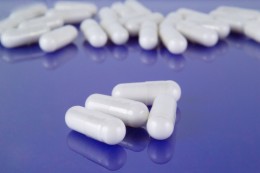Newly Discovered Alpha Lipoic Acid Benefits
Alpha lipoic acid is known as one of the most powerful antioxidant nutrients available to combat oxidative stress.
 Adding antioxidant supplements, particularly alpha lipoic acid, to calcium and vitamin D seems to increase bone mineral density more than calcium and vitamin D alone, according to a group of Italian researchers investigating alpha lipoic acid benefits. A recent study published in Clinical and Experimental Obstetrics and Gynecology found that women with osteopenia who took alpha lipoic acid plus vitamins E, C, and selenium with their calcium and vitamin D had better bone mineral density than those only taking calcium and vitamin D.[1]
Adding antioxidant supplements, particularly alpha lipoic acid, to calcium and vitamin D seems to increase bone mineral density more than calcium and vitamin D alone, according to a group of Italian researchers investigating alpha lipoic acid benefits. A recent study published in Clinical and Experimental Obstetrics and Gynecology found that women with osteopenia who took alpha lipoic acid plus vitamins E, C, and selenium with their calcium and vitamin D had better bone mineral density than those only taking calcium and vitamin D.[1]
While it has been known for almost a decade that oxidative stress is involved in the loss of bone mineral density in osteopenia and osteoporosis, few studies have looked at whether lowering oxidative stress by taking antioxidants like alpha lipoic acid benefits bone density. Alpha lipoic acid is known as one of the most powerful antioxidant nutrients available to combat oxidative stress. The body manufactures alpha lipoic acid in small quantities, but recent research has confirmed that much larger amounts can treat a number of chronic conditions and age-related degenerative processes.
Knowing that antioxidant defenses are significantly decreased in elderly women with osteoporosis, and that oxidative stress impacts bone loss in women after menopause, Dr. Gianpaolo Mainini and colleagues from San Leonardo Hospital in Naples, Italy, evaluated the effects of alpha lipoic acid on bone mineral density in postmenopausal women. They enrolled 50 postmenopausal women with osteopenia in their study, randomly assigning half to receive alpha lipoic acid and other antioxidants (vitamin C, vitamin E, and selenium) plus calcium and vitamin D3, and half to receive only calcium and vitamin D3.
Alpha lipoic acid benefits include better bone mineral density
The subjects’ bone mineral density was estimated at baseline and after 12 months of treatment. Forty-four patients completed the one-year study: 23 in the alpha lipoic acid group, 21 in the control group. Treatment with alpha lipoic acid led to better bone mineral density scores compared to the control group and the differences were statistically significant.
Although these results showing alpha lipoic acid benefits were in a small population, the researchers concluded that oral supplementing with alpha lipoic acid and other antioxidant agents may mitigate bone loss in postmenopausal women with osteopenia.
How does alpha lipoic acid work to stop bone loss?
Previous laboratory and animal studies investigating potential alpha lipoic acid benefits in osteoporosis found that this compound inhibits osteoclasts, the molecules responsible for breaking down bone during the normal cycle of bone build-up and break-down.[2] In osteopenia and osteoporosis, osteoclast activity outpaces osteoblast (bone-building) activity, leading to decreased bone density and increased risk of fractures. Reactive oxygen species are partially responsible for the increase in osteoclasts that cause bone loss in osteoporosis. The earlier studies showed that when alpha lipoic acid is applied to bone cells in the laboratory, it suppresses the formation of bone-degrading osteoclast cells in a dose-dependent fashion. It also was found in animal studies to reduce bone loss caused by inflammation.
Is the R-lipoic acid form better for obtaining alpha lipoic acid benefits?
Lipoic acid exists in two chemical forms which are optical isomers that are mirror images of each other (R-lipoic acid and S-lipoic acid). Only the R-isomer is synthesized and utilized by the body. Alpha lipoic acid supplements may contain either R-lipoic acid or a 50/50 (racemic) mixture of R-lipoic acid and S-lipoic acid; and most supplements contain the 50/50 mixture. You may see advertisements suggesting superiority for R-lipoic acid as opposed to the mixture. Supplements that claim to contain only R-lipoic acid are more expensive. According the to the Linus Pauling Institute, where much of the cutting-edge alpha lipoic acid research has taken place, virtually all of the published studies of lipoic acid supplementation in humans have used the 50/50 mixture and, at this time, it is still not clear whether R-lipoic acid supplements are more effective in humans. Nor do we know for sure whether a lower dose of the R-form would be equivalent to a higher dose of the 50/50 mixture. Both are safe, so at this point, you may want to let your pocketbook help decide which form of alpha lipoic acid you purchase.
How to take advantage of alpha lipoic acid benefits for natural osteopenia treatment and osteoporosis prevention
Alpha lipoic acid is available as a dietary supplement without a prescription in the U.S. If you want to experience alpha lipoic acid benefits, try adding it along with vitamins C and E and selenium to your current osteoporosis treatment plan, aim for at least 600 mg alpha lipoic acid, 500 mg vitamin C, 400 IU natural vitamin E (d-alpha tocopherol), and 100 mcg of selenium per day on an empty stomach. The study also included 500 mg of calcium and 1000 IU of vitamin D per day. Of course, osteopenia and osteoporosis treatment and prevention will always require a comprehensive plan. The best results may be obtained by utilizing an integrative approach to therapy.
[1] Clin Exp Obstet Gynecol. 2012;39(4):489-93.
[2] Free Radic Biol Med. 2006 May 1;40(9):1483-93.
Originally published in 2013, this blog has been updated.


 Bone Spurs on the Spine
Bone Spurs on the Spine  Knee Injections for Osteoarthritis Pain Relief
Knee Injections for Osteoarthritis Pain Relief  What Is a Slipped Rib?
What Is a Slipped Rib? 